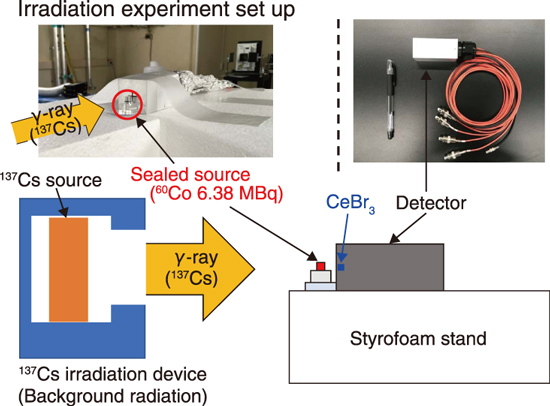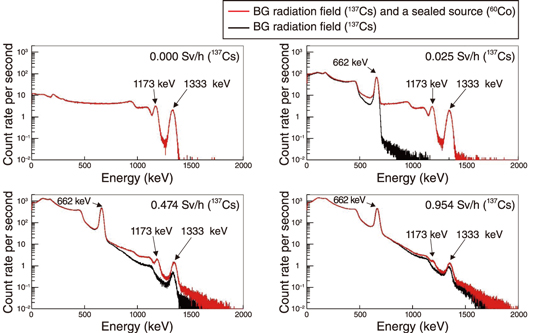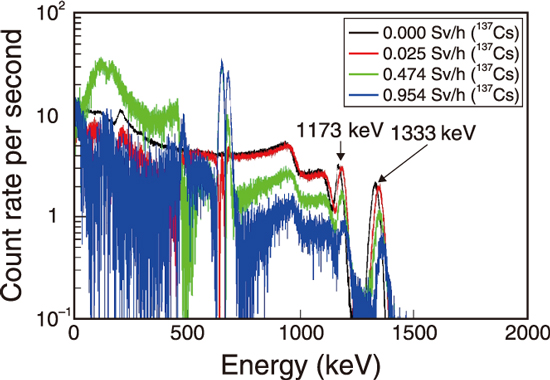
Fig.1-12 Radioactive source (60Co) measurement in 137Cs radiation field

Fig.1-13 Influence of background (BG) radiation on the radioactive source (60Co) measurement

Fig.1-14 Subtracted spectra (Spectra subtracted from BG radiation)
During the decommissioning of the TEPCO’s Fukushima Daiichi NPS (1F), radiation measurements in severe environments (high dose rates and narrow places) are being explored. In addition to measurements of major contaminant radionuclides (137Cs and 90Sr), nondestructive assays for 154Eu, 60Co, and 244Cm, and nuclear materials (U and Pu) will be targeted for the 1F radiation measurements. To realize simple nondestructive assays, which can identify various γ-ray nuclides in high dose-rate radiation fields without heavy shielding, we are developing compact radiation detectors.
To meet the demands, we developed a γ-ray spectrometry system specific to environments at high dose rates. The system is mainly composed of (I) a small CeBr3 scintillator package (5 mm × 5 mm × 5 mm), (II) a fast digital signal-processing system, and (III) a photomultiplier tube with additional power supplies to the later dynode stages. In γ-ray fields (137Cs and 60Co) at dose rates greater than 1 Sv/h, it was already demonstrated that the system had sufficient energy resolution for use in radionuclide analysis (5.2% at 662 keV and 4.2% at 1333 keV).
Furthermore, identifications of radionuclides except for 137Cs are required in 1F. The γ-ray spectroscopy of a sealed 60Co source (6.38 MBq) was performed (Fig.1-12) while varying the intensity of the 137Cs radiation (i.e., background radiation: BG radiation).
Fig.1-13 shows the γ-ray spectra of the 60Co source and the BG radiation (red line), and those attributed only to the BG radiation (black line). As the BG dose rate increased, the full energy peaks of 60Co (1173 and 1333 keV) were buried with the continuum owing to the BG radiation. The phenomenon occurred when multiple 662 keV γ-rays emitted from 137Cs (137mBa) were detected within time intervals shorter than the pulse rising time (sum effect); this problem cannot be solved by pulse signal-processing. Therefore, γ-ray spectra subtracted from the BG radiation (i.e., subtracted spectra) were introduced (Fig.1-14). In the subtracted spectra, the peak at 1173 keV, which was buried within the γ-ray spectra, was identified at 0.954 Sv/h, and the 60Co nuclide was identified. To quantify the source intensity, effective areas of the full energy peak for the subtracted spectra (Sp) were estimated. A comparison of Sp without BG irradiation (0.000 Sv/h) to those at 0.954 Sv/h showed that Sp was one-fifth (0.23) at 1173 keV and one-fourth (0.27) at 1333 keV.
In this research, to integrate the specific γ-ray spectrometry system and spectral analysis, a γ-ray nuclide that was not the principal nuclide (137Cs) was successfully identified under the BG radiation field at a dose rate of almost 1 Sv/h. The system will be developed further for use under higher dose rates, and the influence of BG radiations on quantifications of radionuclides will be reduced.
This research was performed in collaboration with the University of Tokyo and the National Institute of Advanced Industrial Science and Technology.
(Masaaki Kaburagi)